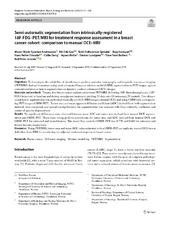| dc.contributor.author | Andreassen, Maren Marie Sjaastad | en_US |
| dc.contributor.author | Goa, Pål Erik | en_US |
| dc.contributor.author | Sjøbakk, Torill Eidhammer | en_US |
| dc.contributor.author | Hedayati, Roja | en_US |
| dc.contributor.author | Eikesdal, Hans Petter | en_US |
| dc.contributor.author | Deng, Callie | en_US |
| dc.contributor.author | Østlie, Agnes | en_US |
| dc.contributor.author | Lundgren, Steinar | en_US |
| dc.contributor.author | Bathen, Tone Frost | en_US |
| dc.contributor.author | Jerome, Neil Peter | en_US |
| dc.date.accessioned | 2020-06-19T14:13:14Z | |
| dc.date.available | 2020-06-19T14:13:14Z | |
| dc.date.issued | 2019-09-27 | |
| dc.Published | Andreassen MMS, Goa PE, Sjøbakk TE, Hedayati R, Eikesdal HP, et al. Semi-automatic segmentation from intrinsically-registered 18F-FDG-PET/MRI for treatment response assessment in a breast cancer cohort: comparison to manual DCE-MRI. Magnetic Resonance Materials in Physics, Biology and Medicine. 2020;33:317–328 | eng |
| dc.identifier.issn | 0968-5243 | |
| dc.identifier.issn | 1352-8661 | |
| dc.identifier.uri | https://hdl.handle.net/1956/22779 | |
| dc.description.abstract | Objectives: To investigate the reliability of simultaneous positron emission tomography and magnetic resonance imaging (PET/MRI)-derived biomarkers using semi-automated Gaussian mixture model (GMM) segmentation on PET images, against conventional manual tumor segmentation on dynamic contrast-enhanced (DCE) images. Materials and methods: Twenty-four breast cancer patients underwent PET/MRI (following 18F-fluorodeoxyglucose (18F-FDG) injection) at baseline and during neoadjuvant treatment, yielding 53 data sets (24 untreated, 29 treated). Two-dimensional tumor segmentation was performed manually on DCE–MRI images (manual DCE) and using GMM with corresponding PET images (GMM–PET). Tumor area and mean apparent diffusion coefficient (ADC) derived from both segmentation methods were compared, and spatial overlap between the segmentations was assessed with Dice similarity coefficient and center-of-gravity displacement. Results: No significant differences were observed between mean ADC and tumor area derived from manual DCE segmentation and GMM–PET. There were strong positive correlations for tumor area and ADC derived from manual DCE and GMM–PET for untreated and treated lesions. The mean Dice score for GMM–PET was 0.770 and 0.649 for untreated and treated lesions, respectively. Discussion: Using PET/MRI, tumor area and mean ADC value estimated with a GMM–PET can replicate manual DCE tumor definition from MRI for monitoring neoadjuvant treatment response in breast cancer. | en_US |
| dc.language.iso | eng | eng |
| dc.publisher | Springer | eng |
| dc.rights | Attribution CC BY | eng |
| dc.rights.uri | http://creativecommons.org/licenses/by/4.0/ | eng |
| dc.subject | Breast cancer | eng |
| dc.subject | Difusion imaging | eng |
| dc.subject | Mixture modelling | eng |
| dc.subject | PET/MRI | eng |
| dc.subject | Segmentation | eng |
| dc.title | Semi-automatic segmentation from intrinsically-registered 18F-FDG-PET/MRI for treatment response assessment in a breast cancer cohort: comparison to manual DCE-MRI | en_US |
| dc.type | Peer reviewed | |
| dc.type | Journal article | |
| dc.date.updated | 2020-01-29T08:48:44Z | |
| dc.description.version | publishedVersion | en_US |
| dc.rights.holder | Copyright 2019 The Author(s) | |
| dc.identifier.doi | https://doi.org/10.1007/s10334-019-00778-8 | |
| dc.identifier.cristin | 1748369 | |
| dc.source.journal | Magnetic Resonance Materials in Physics, Biology and Medicine | |

